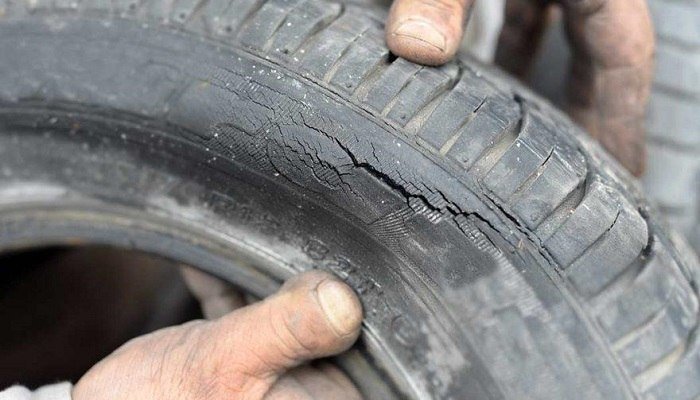by Joshua Thomas
There is no doubt that the tires are one of the most important parts of a vehicle. Without tires, you would not be able to move the car. But, like any other part or component in the vehicle, they will still not last forever as they are prone to wear and tear.
One of the most common issues that you will have to deal with when it comes to tire wear and tear is cracking or dry rot as it is also fondly referred to as, and as the name suggests, this is when the tires start developing small cracks.
While most mechanics will often advise you to replace the cracked tires, this means having to shell out a lot of cash. But, if you are not ready to buy new tires, it is possible to fix cracked tires, and here we show you how and also explain the main causes and possible ways to prevent it.
Contents


Before you grasp how to fix cracked tires, it is a great idea to first understand the causes of cracked tires as this will help you prevent dry rot in the first place. Here are the most common causes of cracked tires.
High humidity and extreme temperatures are one of the main causes of cracked tires. With high humidity, the rubber deteriorates fast and cracking is often one of the signs of this.
For temperature, the high scorching sun will crack and breakdown different compounds in the rubber that give it the strength. Also, at low freezing temperatures, the rubber dries out and turns rigid, which makes it more prone to cracking.
Extended periods of disuse will not only ruin your engine and cause metal parts to rust, but it can also lead to dry rot.
Tires will contain various useful compounds such as antioxidants and oils which help to keep it in good shape and ensures long service life.
When you keep the vehicle parked in one place for a long time, these compounds leach into the ground or evaporate, and so they will be nothing to protect the tires from cracking.
It is always important to make sure that you get your vehicle’s pressure right because under or over pressurizing them often comes with problems and dry rot is one of them.
If you under pressurize the tires, there will be more friction between them and the road given that more of the underinflated surface comes into contact with the road and hence generating more heat, which then causes cracking.
With the over-pressurized tires, there will be extra stress applied on the walls of the tires which often leads to bulging and ultimately to tears and cracks.
Read More: The Best Tire Pressure Monitoring System
If at the onset you buy tires made from low-quality materials, they will be more prone to common problems like dry rot.
Low-quality rubber and other tire materials will not be able to handle the elements that the tires are exposed to such as heat and cold well, and this makes them more prone to cracking than those made from good quality rubber.
Even if you buy the best quality tires, like everything else in your vehicle, they will have a lifespan. As they encounter natural wear and tear as they age, tires will often start developing small cracks.
Exposing the tires to different elements for thousands of miles over many years will eventually lead to deterioration of the rubber, and cracking is one of the main signs of this.

Before you decide to replace your cracked tires, it is worth trying to fix them first as this will save you a lot of cash. And it is easier to do than you might think as you only need a few things and some free time to spare.
The first method is more like sealing a puncture, and it will be more effective for the smaller cracks that are hard to see. And the most important thing with this method will be to make sure that you use a sealant meant for dry rot and cracking is designed for the particular tire type you have.
Things You Need
Directions
Step 1: Allow Vehicle to Cool Down
Before working on your tires, it is always important to allow the tires to cool down first. Since tires are in contact with the road, the friction causes them to heat up and will hence be dangerous to work on when hot.
Step 2: Remove the Tires
Once the tires are cool enough, the next step is to remove them because you will not be able to seal them effectively when they are still on the vehicle.
Also, jacking up your car and removing the tires is vital because dry rot will in many instances affect both the inside and outer parts of the tires, and you can only see this when the tire is removed.
Step 3: Examine the Tires
Next, you need to examine the tires thoroughly to determine the extent of the damage and hence come up with an appropriate plan to tackle the problem.
By inspecting the tires, you can determine the areas most affected, and hence where you will need to pay more attention. Also, it is at this step where you will be able to tell whether the tires are beyond repair or not.
Step 4: Prepare and Apply Sealant
With a clear idea of where the cracks are and their extent, you can now prepare the sealant for application if the type you are using requires some preparation like mixing.
And once the sealant is ready, you should apply it to the tire's interior following the included instructions. For most types, this will involve inserting the nozzle or injector into the valve stem.
Step 5: Reinflate Tire
Next, reinflate your tires and make sure you use the pressure gauge to ensure you get the pressure level right. Reinflation is important because you will likely lose air when working on the tires.
Step 6: Install the Tires and Drive Around
The last step is to reinstall the tires so that you can give the vehicle a drive around. A drive around is important here as it will ensure that the sealant circulates inside the tires to seal all the cracks. But, some sealants will still be able to seal the cracks effectively even without driving around.
When dealing with larger and more visible cracks, an external sealing using a protectant will be more appropriate. This method will also be great when you want to rejuvenate the tire’s rubber and also give it protection from UV rays.
Things You Need
Directions
Step 1: Allow the Vehicle to Cool Down
Before you start working, you will need to wait for the car to cool down or until the tires are not warm to the touch to ensure safe operation.
Step 2: Remove and Inspect the Tires
The next step is to jack up the vehicle and remove the cracked tires. Like with the interior sealing method above, you cannot work effectively when the tires are still in the vehicle.
Once the tires are removed from the vehicle, you need to inspect them thoroughly to determine the location and size of all the cracks.
Step 3: Degrease the tire Surface
After identifying the extent of the cracks, the next step is to start working on them. Here the first thing that you will need to do is to apply the degreaser.
And while each degreaser will come with its specific application instructions, most will require you to apply a little of it on a sponge and then spread it generously over the tire making sure you cover the entire surface.
Also as you are degreasing, you need to make sure that you scrub the tire and concentrate more on the areas with the cracks.
Step 4: Wipe Down and Rinse Tires
The next step is to wipe down the surface of the tires with some clean rugs, but this will be after allowing the degreaser to sit on the tires for a while.
After the wipe down, the next step is to rinse the tires with the hose, and you should make sure you do it thoroughly and then leave them to air dry for a while.
Step 5: Apply Tire Protectant
Once the tires are completely dry, you can now move to the most important step of the process which is applying the tire protectant.
You will need to spray or apply the tire protectant on the tire’s surface depending on the type. Here you need to make sure that you cover the entire surface and not just the areas with the cracks.
Most protectants will require some time to cure, and so you might need to leave the tires for a few hours for the curing.
Step 6: Reinstall Tires
After the curing, the last step will be to give the tires another inspection to see if there are any visible changes. And if you are satisfied with the results, you can now reinstall the tires, and if not, you should repeat the process a few more times.
Note: This method takes a little more time than the first one above as there are a few extra things you will need to do, and so you need to spare at least one or two hours.
While it might be possible to fix cracked tires, they will still not be in the same shape as they were when new. Hence, you will be better off ensuring that your tires do not get cracks in the first place. Here are a few tips to help with this.
As the vehicle tires age, cracks might be inevitable as the rubber will deteriorate and lose some of the strength which allows dry rot to set in and hence resulting in cracks.
But while the decay and deterioration process is part of the tire’s natural life cycle, the good news is that there are still some easy methods to fix the problem. These easy fixes can entail both sealing the tires from the inside using a sealant or from the outside with a protectant.
With all that said, it is also worth remembering that technically you will not be repairing the tires but will only be slowing down the cracking or dry rot process. Hence, the best idea will be to prevent the dry rot by following the tips highlighted above.
 |
 |
 |
 |

About Joshua Thomas
Joshua Thomas just simply loves cars and willing to work on them whenever there's chance... sometimes for free.
He started CarCareTotal back in 2017 from the advices of total strangers who witnessed his amazing skills in car repairs here and there.
His goal with this creation is to help car owners better learn how to maintain and repair their cars; as such, the site would cover alot of areas: troubleshooting, product recommendations, tips & tricks.
Joshua received Bachelor of Science in Mechanical Engineering at San Diego State University.
Just Car Care